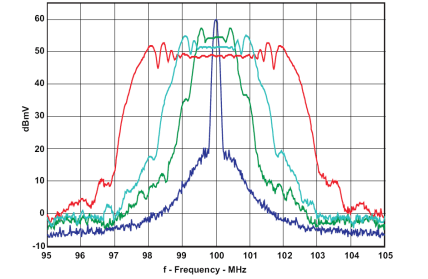ZHCS385D June 2013 – February 2024 CDCE913-Q1 , CDCEL913-Q1
PRODUCTION DATA
- 1
- 1 特性
- 2 应用
- 3 说明
- 4 Device Comparison
- 5 Pin Configuration and Functions
- 6 Specifications
- 7 Parameter Measurement Information
- 8 Detailed Description
- 9 Application and Implementation
- 10Register Maps
- 11器件和文档支持
- 12Revision History
- 13Mechanical, Packaging, and Orderable Information
9.2.2.1 Spread-Spectrum Clock (SSC)
Spread-spectrum modulation is a method to spread emitted energy over a larger bandwidth. In clocking, spread spectrum can reduce electromagnetic interference (EMI) by reducing the level of emission from the clock distribution network.

CDCS502 with a 25-MHz crystal, FS = 1, fOUT = 100 MHz, and 0%, ±0.5, ±1%, and ±2% SSC
Figure 9-4 Comparison Between Typical Clock Power Spectrum and Spread-Spectrum ClockSpread-spectrum clocking can be used to help reduce EMI to meet design specifications. For example, a specified EMI threshold of 55 dB/mV would require ±1% spread-spectrum clocking to meet this requirement.